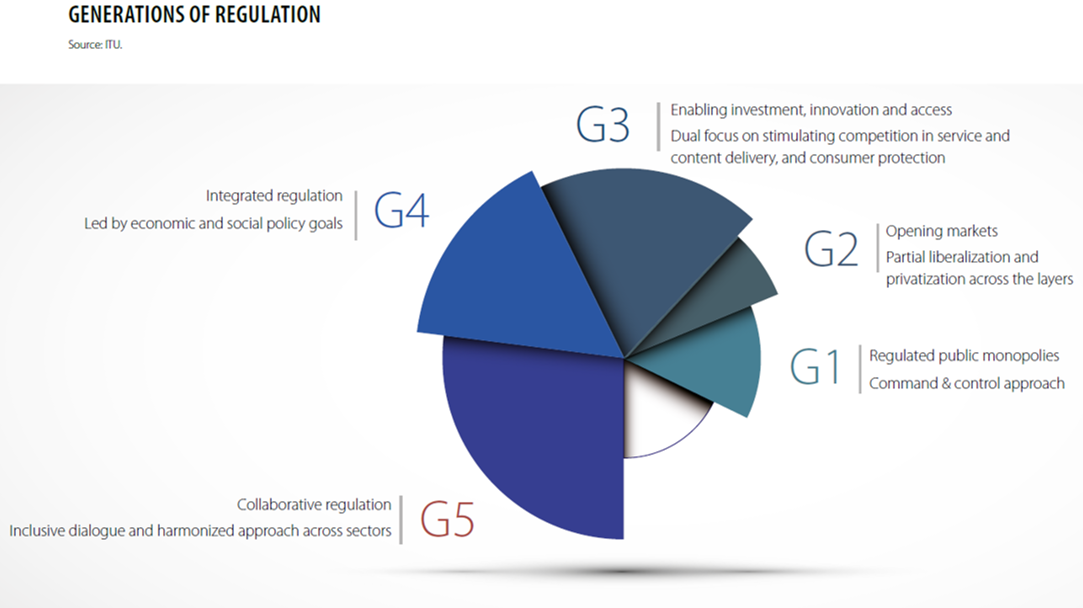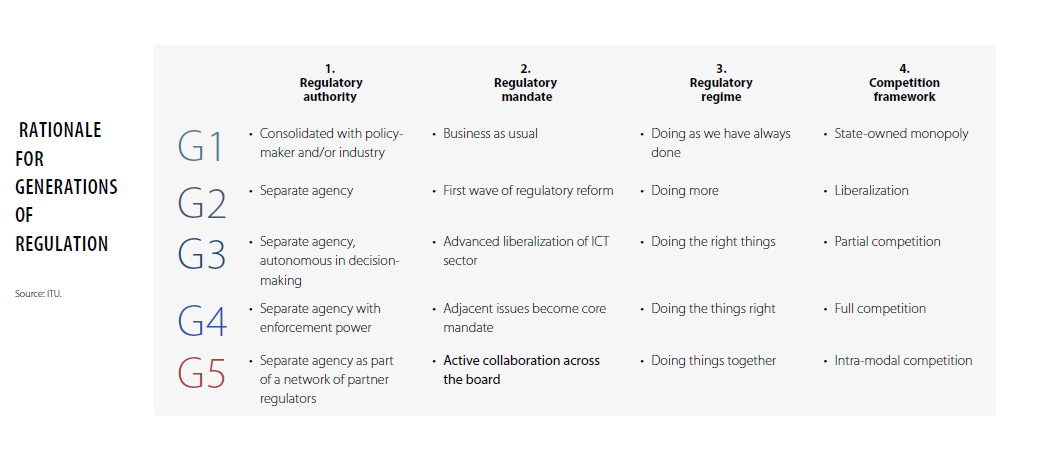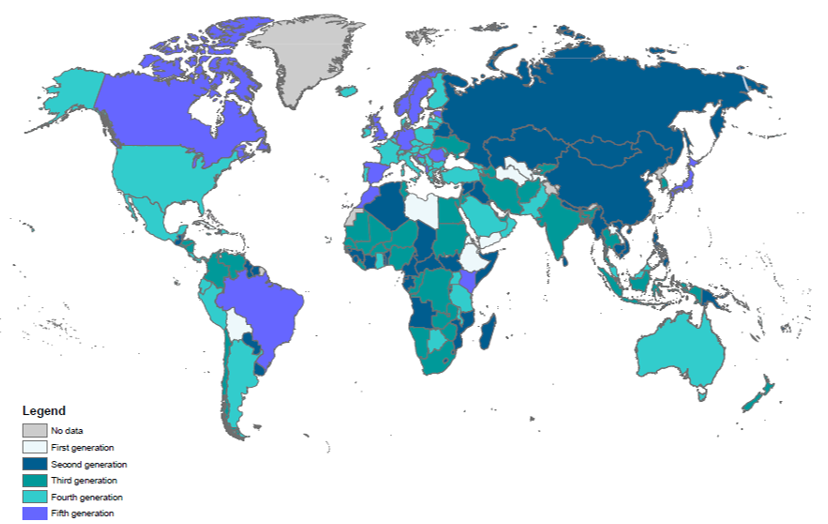
Leading the way
ITU has been producing leading research and analysis on ICT policy and regulation for over 25 years. Policy advice and regulatory best practice guidelines published by ITU have accompanied ICT regulators from their creation through their journey towards digital transformation of economies and societies.
Generations of regulation
Since 2017, in the Global ICT Regulatory Outlook series we explored the evolution of ICT regulatory trends over the preceding decade. We set out the ITU concept of 'generations' of ICT regulation - now widely shared - analysing prime evidence and charting possible ways forward.
Thus far, five generations of regulation have been identified, starting with the command and control approach of the first generation through to a fifth generation based on collaboration that is harmonized across sectors.

Tracking the evolution of regulatory frameworks
The
ICT Regulatory Tracker tracks the transition of countries through generations one to four. The Trackers' indicators correspond closely to the guiding principles outlined in the
ITU Best Practice Guidelines of the Global Symposiums for Regulators (GSR) adopted annually by the global community of ICT regulators. The Best practice Guidelines are considered as the core of modern ICT regulation and the expression of collective wisdom of the current bodies in charge of ICT regulation. 
The rise of G4 regulation has proved unstoppable. By the end of 2018, a third of countries had climbed aboard the bandwagon - no longer an exclusive club - of fourth generation regulators; there was a single G4 regulator in 2008. In just ten years, G4 has become the gold standard for every ICT regulator.
G5 regulation, collaborative regulation, is the desired destination for regulation at this point in time and one that can drive ICT markets globally on the way to digital transformation. It is different from G4 regulation in the means it uses and the mechanisms that have been put in place to increase synergies across the sectors and create efficiencies across public administration bodies.
For more trends in the evolution of regulatory frameworks worldwide, read the
Global ICT Regulatory
Outlook 2020 .
|
What does the ICT Regulatory Tracker do?
The ICT regulation landscape is constantly evolving and at an ever-increasing pace. In order to measure and monitor the changes taking place in the telecommunication/ICT regulatory environment, ITU has designed an analytical tool that looks at a variety of traditional and new subjects in order to make sense of this rapid evolution and to anticipate future change.
The ICT Regulatory Tracker has identified major regulatory trends driving the ICT sector since 2007 and tracks countries' progress from G1 command and control regulation through to G5 collaborative regulation. It facilitates benchmarking and the identification of trends in ICT legal and regulatory frameworks. It helps track progress and identify gaps in regulatory frameworks, making the case for further regulatory reform towards achieving a vibrant and inclusive ICT sector.
Based on high-quality data from 193 countries, the Tracker uses 50 indicators organized across four pillars: regulatory authority, regulatory mandate, regulatory regime, competition framework. An in-depth external audit by the European Commission's renowned science and knowledge service (COIN) has found that the Tracker is a conceptually sound, statistically coherent and robust monitoring tool.
 |
Collaborative regulation: a forward-looking concept
ITU forged 'collaborative regulation' in 2016 and have tested it annually at every Global Symposium for Regulators (GSR) since. While the concept continues to evolve, it can best be cast in 2020 as a framework to discuss the evolution of regulatory pattern and policy while charting the way ahead for industry and regulators as one constituency, towards digital transformation.
Collaborative regulation or 5th generation regulation (G5) is a broad notion that ITU has defined based on the concept of generations of ICT regulation. It marks a fundamental shift in the way regulation is executed, its holistic policy ground and the stakeholders that it brings together - from policy-makers, single-sector and cross-sector regulators to market players of any size. It also shifts regulatory focus on behaviours and impact on markets and development.
Collaborative regulation puts a new emphasis on consumer benefits and protection, and leverages the resources of government institutions and industry to deliver them, through organic consultation, collaboration and conciliation. Collaborative regulation is driven by leadership, incentive and evidence rather than by command and control schemes. The concept also refers to the set of new tools used by regulators to tackle the issues related to digital transformation and the data economy.
Generations of regulation - where do we stand in 2019?

Note: The designations employed and the presentation of the material in this publication do not imply the expression of any opinion whatsoever on the part of ITU concerning the legal status of any country, territory, city or area or of its authorities, or concerning the delimitation of its frontiers or boundaries.
Source: ITU
For an in-depth analysis on the collaboration practices among regulatory agencies, read the
Global ICT
Regulatory Outlook 2018 .
For the current state of collaborative regulation globally, read the
Global ICT Regulatory Outlook 2020 .
|
G5 Benchmark
The Benchmark of Fifth Generation Collaborative Regulation (G5 Benchmark) is new as of 2019. It sets out new goals for regulatory excellence and is the gold standard for collaboration amongst regulators, and for digital policy design that accelerates digital transformation. It is based on data from 84 mostly mature G4 countries and on GSR19 Best Practice Guidelines. This data is then organized across three regulatory tracks using 25 indicators. The Benchmark both complements and builds on the ICT Regulatory Tracker.
* Note that the term 'G5' used in relation to the Benchmark should not be confused with '5G' which refers to wireless technology.
|
